07 Kawasaki Ninja Zx6r
Kawasaki ZX-6R Ninja
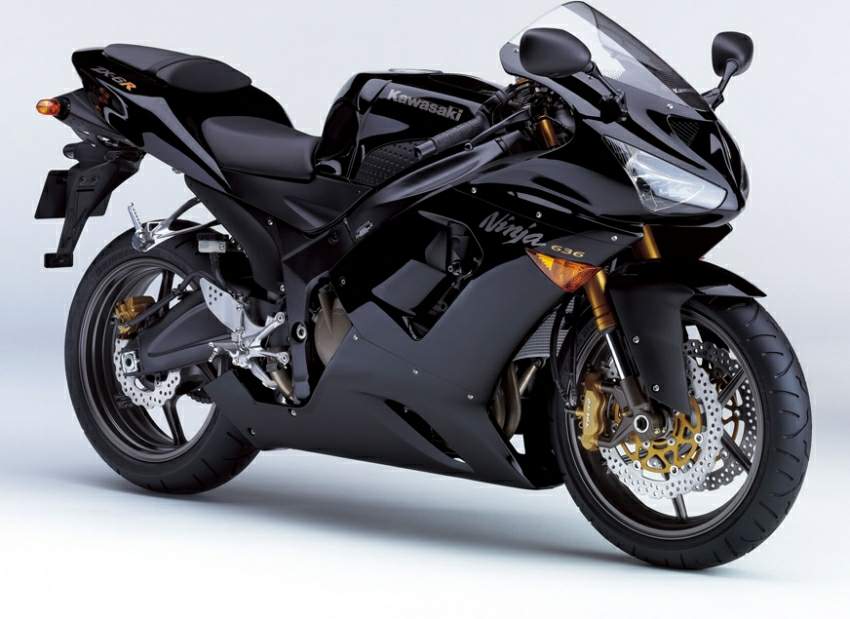
| Make Model | Kawasaki ZX-6R |
| Year | 2007 |
| Engine | Four stroke, transverse four cylinder, DOHC, 4 valves per cylinder |
| Capacity | 599 cc / 36.6 cub in |
| Bore x Stroke | 67 x 42.5 mm |
| Compression Ratio | 13.9:1 |
| Cooling System | Liquid cooled |
| Induction | DFI� with four 38mm Keihin throttle bodies, oval sub-throttles, two injectors per throttle body |
| Lubrication | Wet sump |
| Ignition | TCBI with Digital advance |
| Starting | Electric |
| Spark Plug | NGK, CR 9 E |
| Motor Oil | Synthetic, 10-60 |
| Max Power | 91.9 kW /125 hp @ 14000 rpm |
| Max Torque | 66 Nm / 6.73 kgf-m / 48.7 lb-ft @ 11700 rpm |
| Clutch | Wet, multiple discs, cable operated |
| Transmission | 6 Speed |
| Final Drive | X-ring chain |
| Frame | Perimeter, pressed-aluminium |
| Front Suspension | 41 mm inverted cartridge fork with top-out springs, stepless rebound damping, stepless compression damping, fully-adjustable spring preload |
| Front Wheel Travel | 120 mm / 4.5 in |
| Rear Suspension | Bottom-Link Uni-Trak� with gas-charged shock, top-out spring and pillow ball upper mount, dual-range (high/low-speed) stepless compression damping, 25-way Adjustable rebound damping, fully-adjustable spring preload |
| Rear Wheel Travel | 133 mm / 5.2 in |
| Front Brakes | 2 x 300mm discs, 4 piston calipers |
| Rear Brakes | Single 210mm disc, 1 piston caliper |
| Front Tyre | 120/65 ZR17 |
| Rear Tyre | 180/55 ZR17 |
| Rake | 25� |
| Trail | 109 mm / 4.3 in |
| Dimensions | Length 2105 mm / 2.8 in Width 720 mm / 28.2 in Height 1125 mm / 44.2 in |
| Wheelbase | 1405 mm / 55.3 in. |
| Seat Height | 820 mm / 32.3 in. |
| Dry-Weight | 167 kg / 368 lbs |
| Wet-Weight | 190 kg / 418 lbs |
| Fuel Capacity | 17 Litres / 4.5 US gal |
| Standing � Mile | 11.2 sec |
| Top Speed | 252.1 km/h / 156.4 mph |
KAWASAKI�S 2007 NINJA� ZX�-6R DELIVERS 600-CLASS POWER WITH HANDLING INSPIRED BY 125 GP MACHINES
Quicker and more exciting than any middleweight Ninja sportbike in history
Designed to place its rider on the top step of the podium, the new Ninja� ZX�-6R sportbike elevates 600-class power and handling to the next level. Considering the stellar capabilities of last year�s ZX-6R, Kawasaki�s designers knew it would take a special combination of middleweight power and nimble handling characteristics if they were to make the next leap in middleweight performance. To hone the incredible new machine into an exciting racetrack weapon, Kawasaki appointed a former 125cc Grand Prix racer as the ZX-6R�s chief development rider. The result is an all-new 600 capable of cornering speeds previously unknown to the middleweight class while retaining the wide spread of power that is pure Ninja.
To be quickest around the racetrack a motorcycle requires a wide powerband and plenty of over-rev. The ZX-6R�s all-new engine was redesigned from the crankcase up for the first time in ten years, leading to an ultra-high-rpm powerplant that produces more mid-range torque than any of its predecessors. The result is a fat powerband with a linear torque curve for hard-hitting acceleration across the entire rev range. The Ninja ZX-6R�s impressive over-rev capability mimics a true race bike, allowing riders to stay on the gas where lower-revving machines are forced to shift.
The Ninja ZX-6R�s all-new engine was also specially designed to reduce internal friction. That�s because low-friction engines tend to be more responsive, making it easier for the rider to modify cornering lines with minor throttle adjustments. The new engine components were also made stronger, stiffer and more compact, resulting in an engine which is about 40mm smaller in both width and length than its predecessors. This compact engine allowed the chassis designers to create a slim and compact chassis. Other racing technology includes a close-ratio cassette transmission that makes it easy to keep the Ninja ZX-6R screaming at its horsepower peak and a slipper clutch which allows quicker downshifts without upsetting the rest of the chassis.
In designing the Ninja ZX-6R�s chassis, the development team concentrated on creating a motorcycle that would make fast entry and mid-corner speeds feel easy. A compact, lightweight design allows it to maintain more cornering speed throughout the turn while entry speeds are enhanced by the slipper clutch and powerful radial-mounted front brake calipers. Complementing this track-biased package are fully-adjustable front and rear suspension units. The entire package of frame, suspension, engine and bodywork was designed to enhance the ZX-6R�s fun-to-ride factor by offering a more exciting ride. The results are faster cornering speeds, quicker lap times and even more worried looks on the competition�s faces.
The frame and swingarm were developed with an optimized balance of rigidity, so the Ninja ZX-6R responds instantly and precisely to the rider�s every command. Mass centralization, engine mount locations and a variety of other factors were optimized to help ensure instant turn-in characteristics. Once in the turn, the Ninja ZX-6R holds a line with precision and tracks through the apex as if it were on rails.
All these features mean chassis feedback is very precise, with the ZX-6R communicating every move directly to the rider. The machine responds more precisely and predictably to control inputs and shifts in body weight. The result is a motorcycle that makes the rider feel like a part of the machine.
The new Ninja ZX-6R offers the power of a high-performance 600 Supersport racer mated with the nimble handling characteristics of a small-displacement GP machine. Let the competition compromise performance for rider-friendliness; the new ZX-6R was designed to take home trophies and set the quickest lap times, while being more exciting to ride than anything else in the middleweight sportbike category. The Ninja ZX-6R is a pure expression of Kawasaki�s racing philosophy
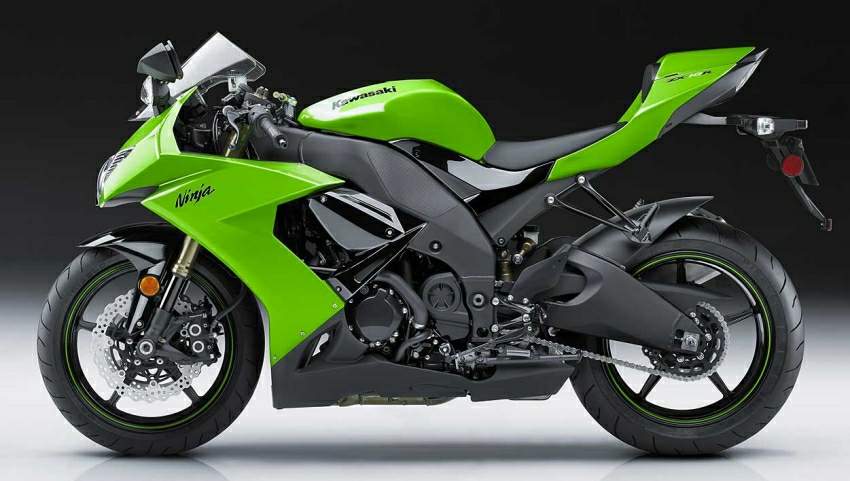
FEATURES:
Key Features
- Incredible power-to-weight ratio
- Race-oriented performance
- Track-tuned handling
- Aggressive new aerodynamic styling
High-Revving 599cc Four-Cylinder, DOHC Engine
- New compact, narrow and lightweight design features a tri-axis crankshaft and transmission shaft layout to optimize the engine�s center of gravity. This helps reduce pitch changes during heavy braking and gives the rider more-accurate feedback from the chassis
- Narrow engine design allows excellent ground clearance
Four-Valve Cylinder Head
- Compact valve train reduces cylinder head height
- Intake ports and coolant passages were developed using flow analysis for efficient cylinder filling, more power, and maximum cooling efficiency
- Forged sintered aluminum spring retainers are half the weight of steel retainers and allow higher rpm
Forged Pistons
- Forged pistons are lighter, stronger and more heat resistant than cast versions.
Ram Air Induction
- Central ram air duct produces a straighter path to the airbox for maximum intake efficiency and provides the mounting surface for the instrument panel, eliminating brackets and weight
- Flow analysis used to design efficient ducts to the airbox that also prevent water from reaching the air filter
- Compact airbox and air cleaner are highly efficient and contribute to the compact riding position
Digital Fuel Injection
- Shorter throttle bodies deliver improved over-rev characteristics
- Smaller throttle bore diameter helps produce more torque in the mid-range
- Ultra-fine atomizing injectors improve combustion efficiency, for better power output and lower fuel consumption
TCBI Ignition with digital advance
- High-speed 32-bit ECU processor provides precise engine management
- Spark plug-mounted ignition coils are compact and help reduce weight
Pre-chamber equipped under-seat Muffler
- New exhaust pre-chamber is located below the engine and contributes to better mass centralization
- Revised under-seat silencer is significantly smaller and lighter to help mass centralization and allow for a more aerodynamic tailsection
- New exhaust header design contributes to improved exhaust efficiency
Six-Speed Transmission
- New cassette-type transmission features a racing-style gear stack to allow easier trackside ratio changes
- Close ratio transmission increases circuit performance
Racing-Style Slipper Clutch
- Racing-type slipper clutch reduces chassis disturbance when making rapid downshifts. This allows the rider dedicate more attention to braking and setting up for the corner
- Optional springs, spring retainers and shims are available to fine-tune the clutch for specific track conditions
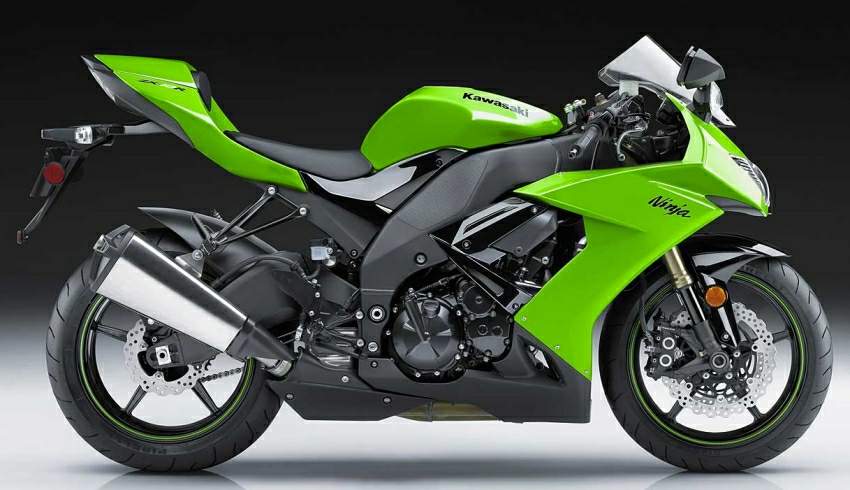
Gear Position Sensor
- The convenient gear position sensor gives instant information to the rider, this is especially useful for improving consistency when testing new settings on the racetrack
- The system compatible with the semi-automatic shifters (legal in AMA Supersport racing) which temporarily cut ignition to facilitate clutchless shifts at full-throttle
Lightweight Twin Spar Aluminum Perimeter Frame
- Combination of pressed and cast aluminum components are welded to form the twin-spar perimeter-type frame. By combining cast and pressed pieces frame weight is kept to a minimum while still providing high strength and stability for responsive handling
- Chassis features optimum center of gravity for easy roll response, this is particularly important when riding through a series of esses or returning to vertical as the rider exits a corner
Uni-Trak� rear suspension
- New Uni-Trak� rear suspension system features pillow ball upper mount in place of the earlier bushings for a more direct feel and improved feedback
- Compact frame and engine allow a longer swingarm, which makes it easier to control rear wheel powerslides
- Rear shock is fully adjustable for preload, compression and rebound damping. Ride height can be adjusted by adding/removing optional 1mm shims at the upper shock mount
- Equipped with a top-out spring which improves the rear wheel�s ability to follow the road surface when the rear end is light due to hard braking
- Small piggyback shock reservoir is designed to save weight
41mm Inverted cartridge front fork
- New fully-adjustable 41mm inverted cartridge fork provides exceptional rigidity
- Equipped with top-out springs which allow the front wheel to better follow the road surface when the front end is light due to hard acceleration
- The main fork spring is located at the bottom of the fork. Because the spring is completely submerged in oil, cavitation is minimized, resulting in stable suspension performance even under demanding racetrack conditions
- Stiff settings are suitable for track use
Radial mounted front disc brakes
- Radial mounted four-piston, four-pad front brake calipers improve brake feel over a wider range of operation
- A separate brake pad is used for each piston. One large pad tends to deform with the heat generated by hard track style riding, resulting in a loss of brake feel at the lever. Individual pads provide increased cooling efficiency and can absorb more heat without deforming so they maintain consistent brake feel lap after lap
- Petal design brake discs offer excellent cooling and warp resistance
Aerodynamic bodywork
- New design is the most aerodynamically efficient of any Ninja sportbike available today
- Light and compact projector beam headlights allow a more aerodynamic fairing
- The new Ram Air duct is small but highly efficient
- The exhaust system includes an under-engine resonator which allows the use of a smaller under-seat muffler. This helps to minimize drag by allowing a cleaner tail section design
- Integrated front and rear turn signals reduce wind resistance
- Three-piece front fender designed for aero efficiency
- Different color panels create a sporty, aggressive image
Riding position
- New ultra-compact chassis places the rider in a ideal position to take advantage of the ZX-6R�s improved handling capabilities, by improving the man-machine interface
- Slimmer fuel tank design makes it easier for the rider to grip the tank and seat when hanging off in a turn
Advanced electronic instrumentation
- Multifunction odometer, tripmeter, clock and lap timer/stopwatch
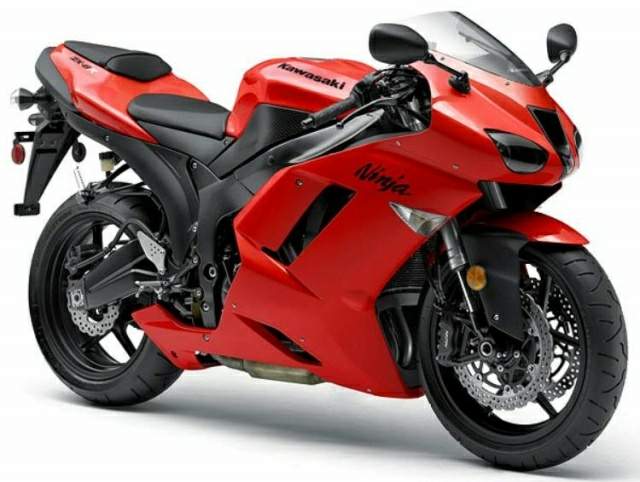
Review
Pity the poor engineers of supersport bikes, forced to juggle seemingly contradictory design directives. It's got to look bitchin' but it can't cost too much, and don't forget to make it go around a racetrack quicker than any of its rabid competitors.
Reflect back just 10 years and you'll see the middleweight class composed of bikes that could easily be used for regular commuting or some light touring, with handlebars mounted above the triple-clamps, accommodating footpeg placement and some storage under the seat. Those days, like the hotel TV set of a petulant rock star, are gone out the window. Now a sporting middleweight needs to be the sharpest tool, as a rider shouldn't be forced to ride anything but the pinnacle of sportbike technology - the most capable scalpel extant.
Well, Kawasaki is down with that program. Its new ZX-6R was developed from the beginning on race tires, not the street shoes earlier models wore during gestation.
"This is a full-blown race bike," said Kawasaki's Karl Edmondson during the bike's press introduction at Barber Motorsports Park in Alabama.
And on the hugely fun and wildly undulating 2.3-mile Barber circuit, the new ZX feels kind of like a race bike. It doesn't take many laps to gain a sense of trust, and it responds unequivocally to a rider's inputs. It feels taut and confident, perhaps more so than any previous Kawasaki.
So how'd they do it - make a better bike than the excellent one that came before it - this time?
It all started where they all do: the engine. In this case it's new from the cases up, the first total redesign for Kawi's middleweight in 10 years. For starters, it was left in the dryer a really long time, shrinking 40mm in both length and width; that's getting on close to 2 inches for those not good with the metric system. Its narrowness was made possible by snuggling its four cylinders closer together, while it was shortened by placing its crankshaft, primary drive and countershaft gears in a tight triangular arrangement like its classmates.
Inside this new architecture reside some reminders of last year's ZX-6RR motor, the 599cc one built for racing. They share the same bore and stroke (67.0mm x 42.5mm), as do the rest of the class challengers. There will be no more cries of "cheater bike!" because Kawasaki will no longer build the 636cc version it's had in the lineup since 2003.
Like before, a set of oval 38mm throttle bodies mix air and fuel, but they are now 8mm shorter which might offer a high-rpm benefit. Like the 6RR, the intake ports are polished for cleaner, faster flow to the 1.5mm larger intake valves (26.5mm) operated by new cam profiles. The forged, short-skirt pistons are lighter, and even the piston pins weigh less, as do the forged- and sintered-aluminum valve spring retainers that reduce weight by half compared to steel pieces. The intake mixture is squeezed at a lofty 13.3:1 compression ratio, which seemed high until I noticed the 13.9:1 ratio of the old 6RR. Exhaust is routed though header pipes that curve sexily before routed into the under-engine pre-muffler/catalyzer; this allows the undertail muffler to be smaller for a tidier tailsection.
So, smaller engine, smaller bike, right? Er, no actually. It's taller and wider, though just fractionally, and it's longer by 1.6 inch. And the new bike must've been born shortly after Thanksgiving, as the specs say it weighs 6 lbs more than last year. If true, it would put the ZX's weight at about 402 lbs with its tank empty. That's still lighter than Suzuki's Gixxer 600, but it might be as much as 19 lbs more than the radically slimmed down '07 Honda CBR600RR.
You'd never guess any of this when you sit on the ZX, as it's slimmer though the middle and a rider sits closer to the front wheel, giving the bike a more compact feel. Bars are closer to the rider and lower. It's a racier place to do business, with footpegs that are placed closer together thanks to that narrower motor.
So let's fire it up, then. Hopefully your first experience on the Zixxer isn't in the 23-degree weather that greeted me for my debut session on a track I hadn't seen before. Nevertheless, I had a job to do. Thankfully our bikes had tire warmers ("Uh, could I stick one of those in my pants.?"), and the Bridgestone BT002 Pros proved to have surprisingly good grip even in these cold conditions. The "Pro" version of the 002s debuted earlier this year, and the medium-compounds we rode on at 28 psi received rosy comments from the assembled scribblers.
Kawasaki's PR literature claims the new 6R "churns out way more midrange torque than its predecessors," but whoever wrote that must not have ridden the burly ZX-636. Perhaps they were referring to the old 6RR that was quite wimpy at lower revs. Still, this new bike doesn't feel especially grunty halfway around the tachometer. It sings up top, though, pulling strongly from 10,000 rpm to its 12,500-rpm peak but with room to spare to its 16,500 redline, again same as the old 6RR.
A glance at the spec charts offers what might be seen as a worrying sign to number crunchers. This '07 ZX is rated at 116.4 hp. Not only is that down from the 124-pony claim of the 636cc 6R, it's also virtually identical to last year's 599cc ZX-6RR.
(As with the previous gen ZX-6R, ECU tuning on U.S. and Canadian models has strangled the top-end power by closing the exhaust powervalve at high revs to meet noise regulations. The European model makes a claimed 123.3 ponies, a healthy boost of almost 7, plus it allows the engine to pull stronger up top, making its peak power 1500 rpm higher. This might be sad, but only if we didn't know how to trick the ECU to default to the Euro spec settings with a free 5-minute mod you can read about here.)
Is this progress? Yes, according to the ZX's engine designer, Takahiro Ono. He notes that getting around a racetrack quickly isn't just a matter of how much power you have, but how early you can dial it on and how well you can put it to the pavement. As an example, he related to me of how the new 800cc MotoGP bikes have been breaking lap records in pre-season testing despite having 24% less displacement than their 990cc forbears. Closer to home, Kawi's engineers claim the '07 bike can lap Kawi's Autopolis racetrack a good 2 seconds quicker than the old RR and at least 3 seconds quicker than the ZX-636.
Whether that's true or not is difficult to say from my seat, but I can attest to a highly cooperative machine, and it's hard to imagine a better mount for learning, then strafing, the hills of the technical BMP. Throttle response is super smooth, with none of the on/off throttle abruptness we despise. Kawi says the ZX's "modified flywheel mass contributes to increased traction," which we'll take to mean that it has more of it, and the theory seems to work.
Also aiding the rider is the ZX's clutch and transmission. First off, kudos must go to the excellent slipper clutch - it's as good as any OEM unit I've tried. Bang a quick and sloppy downshift into Turn 1 without caring about details like rpm, and the back-torque-limiting clutch simply allows revs to match wheel speed. In addition, its amount of slip can be fine-tuned by Kawi's optional race kit pieces. Also available are two optional gear sets for the cassette-style transmission that enables trackside internal gearing changes, the only middleweight with this racer-desirable component. Shift action is light on the ZX, though it can get hung up if you're not careful to let the lever drop all the way after an upshift. Gear ratios are closely spaced, which worked well at the racetrack, though it may not be as optimal for the street.
But where the new 6R really shines is in the corners. Kawasaki pumps up the fact that the bike's chief development rider, Tomomi Manako, is a former 125cc GP rider, and this has supposedly resulted in a bike that boasts higher corner-entrance and mid-corner speeds. The chassis geometry points to nothing unusual, using the same 25.0-degree rake as last year's 6R and a scant 4mm increase in trail. Its wheelbase is up 0.6 inch over the old 636 and nearly identical to the Double-R version at 55.3 inches.
In the morning I was enjoying the assuring stability of the bike, glad that a steering damper was on board to quell any headshake. It was a short while later in the pits when I confirmed that there is no such component on the 6R, a real testament to the core quality of the chassis. Still, fighting with the bars over one of Barber's many rises can induce a minor bar wag, and Kawi offers a ZX-10R-style Ohlins steering damper through its race kit catalog for those who want the insurance it offers.
Some manufacturers like to flaunt percentage changes in torsional or lateral rigidity of their frames, but Kawi is more demure by coyly saying, "The frame's rigidity balance was completely revised to enable the chassis to easily handle mid-corner surface imperfections without upsetting the bike." Reading between the lines, they've probably reduced the lateral rigidity.
The front end provides the kind of direct response that entices a rider to turn it in a little quicker and lean it in a little further. This new ZX provides communication in bigger doses than any other Kawasaki. From a strictly handling perspective, this thing is going to run at or near the sharp end of the supersport field. It takes a fair bit of prodding before pegs are dragged, and ground clearance is certainly not an issue for any street riding.
A critical role in the handling equation is the suspension. The ZX still uses a 41mm inverted fork up front, but its spring is now located at its bottom, fully ensconced by oil to reduce oil cavitation. At the rear, the shock's linkage now uses what Team Green call "pillow balls" where standard bushings are usually found (Insert lewd and juvenile joke here). Both ends are adjustable for preload and compression and rebound damping, and the shock gets the bonus of having its compression adjustments separated into high-speed and low-speed.
It seems like pillow balls are a good thing to have, as feedback from the rear end is generous. The front end is just as good. The braking bumps entering Barber's Turn 5 were sucked up so nicely that I had to be told about the ripples before I noticed them.
Let's also give praise to the Ninja's brakes. These are the same 4-piston, 4-pad radial-mount calipers actuated by a radial-pump master cylinder we've enjoyed for the past two years of ZX-6s, but its 300mm rotors are now 6mm (from 5.5) thick to better shed heat without going to a larger-diameter disc. Ample power, no fade, and best of all, plenty of feedback. Zero complaints here.
And we can't complain about the ZX's hard-to-read tach any longer, as it's now a simple white-faced analog rev counter with red numbers that take just a moment to assimilate. An unmistakable yellow shift light in the upper-left quadrant can be programmed to illuminate at whatever rpm you choose. I was happy to hear the ZX had a gear-position indicator, as it's been our experience that they're handy for riders of all talent levels, but Kawi just couldn't give us a perfect set of gauges. I couldn't believe my eyes when I saw the 6R's indicator, as it's so small that it's useless. Well, it may be readable on an open highway in Nebraska, but certainly not when you're screaming in to Barber's Turn 1 at a-buck-thirty.
Other than that minor faux pas, our only reservation with the '07 ZX-6R is with what seems to be a top-heavy powerband. Kawi talks about "a mile-wide" spread of power, but that might be a bit optimistic. It felt to me as if it might fall between the reasonable GSX-R and the Yamaha R6 screamer. From what Kenny tells me, new CBR600RR is in contention for the most desirable powerband of the 600s.
With its $8999 MSRP, the ZX is $300-$400 cheaper than the R6 and $500 less than the CBR (the GSX-R is just $8899). It was only a few years ago that middleweights crossed the $8000 threshold, and now they're approaching $10K!
As for which bike is going to be the best overall supersport contender, it's too early to tell. In the Kawi's favor is its stellar handling and reasonable price tag.
Source Motorcycle-USA
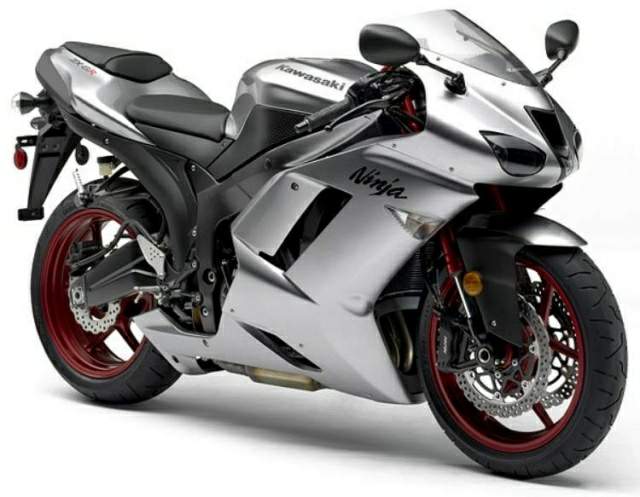
Source: https://www.motorcyclespecs.co.za/model/kawasaki/kawasaki_zx6r%2007.htm

0 Komentar